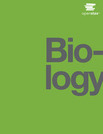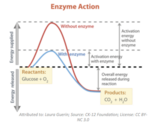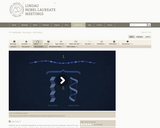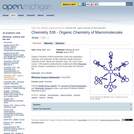
15 Results



Biology is designed for multi-semester biology courses for science majors. It is grounded on an evolutionary basis and includes exciting features that highlight careers in the biological sciences and everyday applications of the concepts at hand. To meet the needs of today’s instructors and students, some content has been strategically condensed while maintaining the overall scope and coverage of traditional texts for this course. Instructors can customize the book, adapting it to the approach that works best in their classroom. Biology also includes an innovative art program that incorporates critical thinking and clicker questions to help students understand—and apply—key concepts.
- Subject:
- Biology
- Life Science
- Material Type:
- Full Course
- Provider:
- Rice University
- Provider Set:
- OpenStax College
- Date Added:
- 08/22/2012

- Subject:
- Biology
- Life Science
- Material Type:
- Unit of Study
- Provider:
- Rice University
- Provider Set:
- OpenStax College

Biology is designed for multi-semester biology courses for science majors. It is grounded on an evolutionary basis and includes exciting features that highlight careers in the biological sciences and everyday applications of the concepts at hand. To meet the needs of today’s instructors and students, some content has been strategically condensed while maintaining the overall scope and coverage of traditional texts for this course. Instructors can customize the book, adapting it to the approach that works best in their classroom. Biology also includes an innovative art program that incorporates critical thinking and clicker questions to help students understand—and apply—key concepts.
- Subject:
- Applied Science
- Material Type:
- Module
- Date Added:
- 07/10/2017

In this seminar students will explore the hacking of glue! You will inquire about the way in which enzymes are a part of chemical reactions in the biological sense through simulations. Experimental investigations will lead to the understanding of the denaturing process of enzymes.StandardsBIO.A.2.2.2 Describe how biological macromolecules form from monomers.BIO.A.2.2.3 Compare and contrast the structure and function of carbohydrates, lipids, proteins, and nucleic acids in organisms.
- Subject:
- Biology
- Life Science
- Material Type:
- Lesson Plan
- Author:
- Bonnie Waltz
- Deanna Mayers
- Tracy Rains
- Date Added:
- 10/08/2017

In this seminar your will experience how the use of polymers is a daily occurrence and compare the processes of how polymers are built for biological systems. You will create a field guide to the biological macromolecules and their respective monomers.StandardsBIO.A.2.2.2 Describe how biological macromolecules form from monomers.BIO.A.2.2.3 Compare and contrast the structure and function of carbohydrates, lipids, proteins, and nucleic acids in organisms.
- Subject:
- Biology
- Life Science
- Material Type:
- Lesson Plan
- Author:
- Bonnie Waltz
- Deanna Mayers
- Tracy Rains
- Date Added:
- 10/08/2017

In this seminar students construct graphic organizers to make sense of the profuse amount of concept specific vocabulary terms as they relate to the structure and function of the 4 biomacromolecules. They will collect data as they test common foods for the presence of these 4 organic molecules in a virtual lab.StandardsBIO.A.2.2.2 Describe how biological macromolecules form from monomers.BIO.A.2.2.3 Compare and contrast the structure and function of carbohydrates, lipids, proteins, and nucleic acids in organisms.
- Subject:
- Biology
- Life Science
- Material Type:
- Lesson Plan
- Author:
- Bonnie Waltz
- Deanna Mayers
- Tracy Rains
- Date Added:
- 10/08/2017

This exercise is designed to help undergraduates understand cellular macromolecules and the monomer/polymer relationships important for cells. The exercise is designed to be performed in class, and includes a guided note-taking table and some short-answer questions that students complete independently to evaluate the structures of sugars and DNA.
- Subject:
- Biology
- Life Science
- Material Type:
- Activity/Lab
- Date Added:
- 07/12/2019

Proteins are an essential ingredient of each and every cell and constitute most of its dry mass. This Mini Lecture explores the chemical structures of the macromolecules and introduces to the specific, three-dimensional constitution of the amino-acid-chain, the buildup and degradation of proteins with lecture snippets of Nobel Laureates Christian Anfinsen and Johann Deisenhofer.
- Subject:
- Chemistry
- Physical Science
- Material Type:
- Lecture
- Provider:
- Lindau Nobel Laureate Meetings
- Provider Set:
- Mini Lectures
- Date Added:
- 04/13/2018

Macromolecules, licensed CC4.0 is adapted by Yaeram Won from Urbi Ghosh
- Subject:
- Biology
- Material Type:
- Diagram/Illustration
- Author:
- Yaeram Won
- Date Added:
- 11/18/2021

Helpful practice/review sheet for comparing and contrasting biological macromolecules and their monomers.
- Subject:
- Anatomy/Physiology
- Biology
- Health, Medicine and Nursing
- Material Type:
- Homework/Assignment
- Author:
- Jessica Sherburne
- Date Added:
- 06/01/2021

The Online Macromolecular Museum (OMM) is a site for the display and study of macromolecules. Macromolecular structures, as discovered by crystallographic or NMR methods, are scientific objects in much the same sense as fossil bones or dried specimens: they can be archived, studied, and displayed in aesthetically pleasing, educational exhibits. Hence, a museum seems an appropriate designation for the collection of displays that we are assembling. The OMM's exhibits are interactive tutorials on individual molecules in which hypertextual explanations of important biochemical features are linked to illustrative renderings of the molecule at hand.
Why devote a site to detailed visualizations of different macromolecules? In learning about the intricacies of life processes at the molecular level, it is important to understand how natural selection has fashioned the structure and chemistry of macromolecular machines to suit them for particular functions. This understanding is greatly facilitated by the visualization of 3-dimensional structure, when known. So, if static views of molecules (even in stereo) are worth a thousand words, then interactive animations of molecules should be worth much more. Indeed, we have found the types of displays represented here invaluable in gaining an appreciation for the details of key biochemical processes.
As Carl Brandon and John Tooze stated in their classic text, Introduction to Protein Structure:
"Molecular biology began some 40 years ago with the realization that structure was crucial for a proper understanding of function. Paradoxically, the dazzling achievements of molecular genetics and biochemistry led to the eclipse of structural studies. We believe the wheel has now come full circle, and those very achievements have increased the need for structural analysis at the same time that they have provided the means for it."
It is our opinion that structural analysis should extend into the classroom: as students learn about cellular mechanisms it is important that they study the chemistry of the molecular machines involved. These considerations have motivated the construction of the OMM.
The OMM is part of a collaborative effort by faculty and students interested in macromolecular structure-function relationships. The primary authors of some tutorials are students of David Marcey and he serves as author, co-author and site editor, and assumes all responsibility for content. Any criticisms, suggestions, comments, or questions should be sent to him at: marcey@callutheran.edu. All tutorials are copyrighted.
The OMM was started in 1996 for a Molecular Biology class at Kenyon College, where DM was a professor in the Biology Department (1990-1999). The OMM is now developed and housed at California Lutheran University, where DM has been a professor since 1999.
- Subject:
- Chemistry
- Life Science
- Physical Science
- Material Type:
- Activity/Lab
- Diagram/Illustration
- Homework/Assignment
- Interactive
- Lesson
- Author:
- David Marcey
- Date Added:
- 09/28/2017

Chemistry 538 - Organic Chemistry of Macromolecules covers the preparation, reactions, and properties of high molecular weight polymeric materials of both natural and synthetic origin. As a part of this course, U-M students collaboratively created and edited÷Wikipediaarticles. Student contributions can be found below, within the "Wikipedia Articles" section.
- Subject:
- Chemistry
- Physical Science
- Material Type:
- Full Course
- Provider:
- University of Michigan
- Provider Set:
- Open.Michigan
- Author:
- Anne McNeil
- Date Added:
- 11/05/2012

In this project, you will explore a real-world problem, and then work through a series of steps to analyze that problem, research ways the problem could be solved, then propose a possible solution to that problem. Often, there is no specific right or wrong solutions, but sometimes one particular solution may be better than others. The key is making sure you fully understand the problem, have researched some possible solutions, and have proposed the solution that you can support with information / evidence.Begin by reading the problem statement in Step 1. Take the time to review all of the information provided in the statement, including exploring the websites, videos and / or and articles that are linked. Then work on steps 2 through 8 to complete this problem-based learning experience.
- Subject:
- Biology
- Life Science
- Material Type:
- Lesson Plan
- Author:
- Bonnie Waltz
- Deanna Mayers
- Tracy Rains
- Date Added:
- 10/08/2017